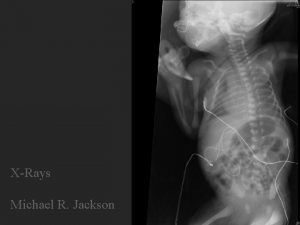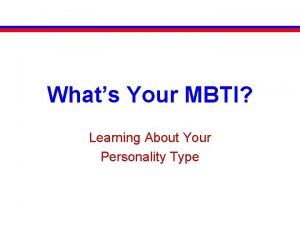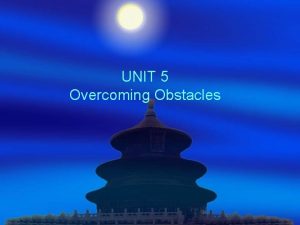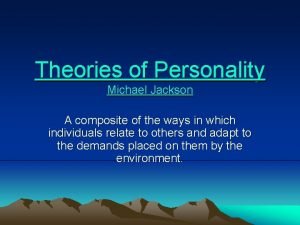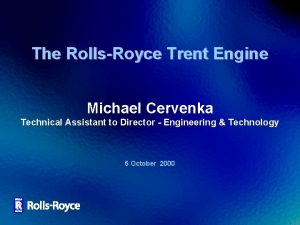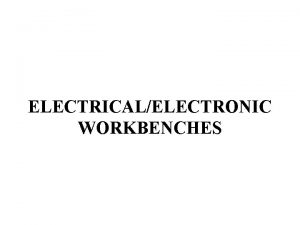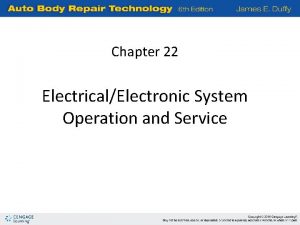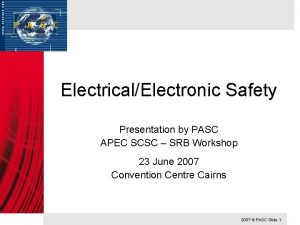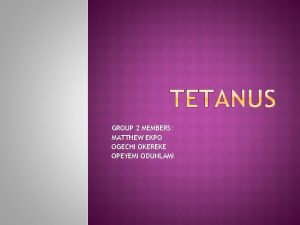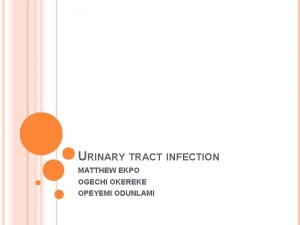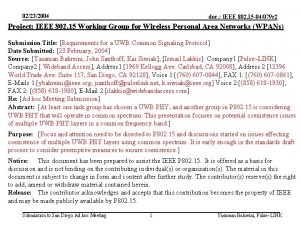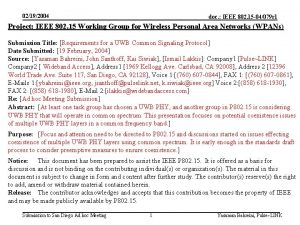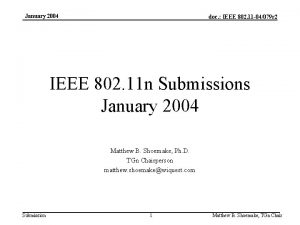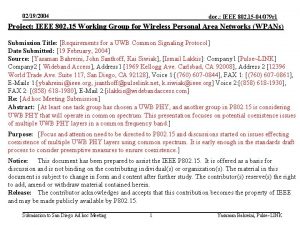MICHAEL EFFIONG EKPO 18ENG 04079 ELECTRICALELECTRONIC ASSESSMENT OF
















- Slides: 16

MICHAEL EFFIONG EKPO 18/ENG 04/079 ELECTRICAL/ELECTRONIC

ASSESSMENT OF OCCUPATIONAL HAZARDS AND DEVELOPMENT OF ENGINEERING EQUIPMENT TO SUPPORT HEALTH WORKERS AGAINST COVID-19

INTRODUCTION Assessing the occupational hazards and development of engineering equipment to support health workers against COVID-19 requires a systematic approach that includes various management functions such as designing, planning, organizing, implementing, monitoring and evaluating actions in an orderly manner.

• A critical part of any Occupational Health and Safety program is the identification, assessment, elimination and/or the control of hazards in the workplace. Risk assessment is the process of evaluation of the risks arising from a hazard, taking into account the adequacy of any existing controls and deciding whether or not the risks is acceptable. It is impossible to eliminate all hazards, so the goal is to eliminate and/or control the hazards with critical and high potential risk to the lowest reasonable risk level so as to protect workers from harm.

DEFINITION Hazard means a source or a situation with a potential for harm in terms of human injury or ill health, damage to property, damage to the environment, or a combination of these Hazard identification means the identification of undesired events that lead to the materialization of the hazard and the mechanism by which those undesired events could occur.

“Hazardous process” means any process or activity in relation to an industry specified in the First Schedule where, unless special care is taken, raw materials used therein or the intermediate or finished products, by-products, wastes, or effluents thereof would: • Cause material impairment to the health of the persons engaged in or connected therewith, or • Result in the pollution of the general environment.

• Risk is, at minimum, a two-dimensional concept involving the possibility of an adverse outcome, and uncertainty over the occurrence, timing, or magnitude of that adverse outcome. If either attribute is absent, then there is no risk. • Risk assessment is a systematic process for describing and quantifying the risks associated with hazardous substances, processes, actions, or events. • Risk assessment method can be defined as any selfcontained systematic procedure conducted as part of a risk assessment – that is, any procedure that can be used to help generate a probability distribution for health or environmental consequences

Scope of the study The occupational health risk assessment shall address the following: • The hazards of the process involved in different activities • Semi-quantitative evaluation of the possible health and safety effects of failure of controls • Engineering and administrative controls applicable to the hazards and their interrelationships, such as appropriate application of detection methodologies to provide early warning of release.

Identification of risk After all the possible hazards were identified, the occupational health risk that could be associated with the hazard was identified by studying previous incident reports, MSDS, first aid/injury records, and health records of the employees. Assessment of risk Risk assessment was done using semi quantitative method based on two key factors

• The likelihood that the injury (or illness) may actually occur • The severity of the injury (or illness) resulting from the hazard. Control of risk • Risk rating can prioritize hazards with the highest potential to cause an injury so that they can be eliminated first. The following steps were taken for the control of risk: • Quick attention to critical or high-risk hazards • Effective temporary solutions until permanent fixes were applied

• Long-term solutions for those risks which can cause long-term illness • Long-term solutions for those risks with the worst consequences • Training of workers on the risks, which continue to remain and its control measures • Regular monitoring to check whether control measures are intact or not.


Acceptable risk Risk that is acceptable to regulatory agency and to the public is called acceptable risk. There are no formally recognized regulatory criteria for risk to personnel in the mining industry. Individual organizations have developed criteria for employee risk and the concepts originally arising from chemical process industries and oil and gas industries. Because of the uncertainties linked with probabilistic risk analysis used for quantification of the risk levels the general guiding principle is that the risk be reduced to a level considered ALARP.

Preventive measures The aim of implementation of prevention measures is to reduce the likelihood of work accident or occupational disease occurrence. The measures used are as follows: • Engineering control of risks o Remove – during the workspace designing phase, any equipment not meeting the occupational health standards should not be used o Reduce – levels of hazardous substances can be reduced by proper ventilation through exhaust fans o Replace – high-risk equipment or substances should be replaced by low risk ones. • Administrative control – Training of employees – Workers must know the risks they are exposed to, the harm they might cause, and precautions that could prevent these harmful effects – Work instructions for every activity.

Conclusion The first step for protection of workers against occupational diseases and maintaining a safe workplace is defining and analyzing hazards. There is a need for HIRAC study as a routine practice in all manufacturing industries. This helps in achieving two objectives; first is identifying the critical and high-risk hazards, which need to be addressed on priority basis, and second, by applying control measures at the earliest, it reduces the risk to a level considered ALARP.

REFERENCES • Singh GP, Choudhary RP, Vardhan H, Aruna M, Akolkar AB. Iron Ore Pelletization Technology and its Environmental Impact Assessment in Eastern Region of India - A Case Study. Procedia Earth Planetary Sci. 2015; 11: 582– 97. [Google Scholar] • BSI - British Standard Institutions, Occupational health and safety management systems – Requirements. BS OHSAS 1800. 2007 [Google Scholar] • [Last accessed on 2017 Oct 12]. Available from: https: //www. ilo. org/dyn/natlex/docs/WEBTEXT/320 63/64873/E 87 IND 01. htm. • Director General Department of Occupational Safety and Health, Malaysia. Guidelines for Hazard Identification, Risk Assessment and Risk Control (HIRARC) 208. [Last accessed on 2017 Oct 11]. p. 1. p. 34. Available from: http: //www. dosh. gov. my/index. php? option=com_do cman&task=cat_view&gid=15&Itemid=179&lang=en.
 Principle of portfolio assessment
Principle of portfolio assessment Static assessment vs dynamic assessment
Static assessment vs dynamic assessment Portfolio assessment matches assessment to teaching
Portfolio assessment matches assessment to teaching Michael jackson chest
Michael jackson chest Goldie hawn mbti
Goldie hawn mbti Michael morahan
Michael morahan Michael maesano
Michael maesano Michael stone blind pole vaulter
Michael stone blind pole vaulter Michael ball berkeley
Michael ball berkeley Michael tholander
Michael tholander Michael jackson personality
Michael jackson personality Trent 8104
Trent 8104 Centene cio
Centene cio Michael brin
Michael brin Ruck family massacre
Ruck family massacre Michael jordan bodily kinesthetic intelligence
Michael jordan bodily kinesthetic intelligence Michael collins buzz aldrin and neil armstrong
Michael collins buzz aldrin and neil armstrong



